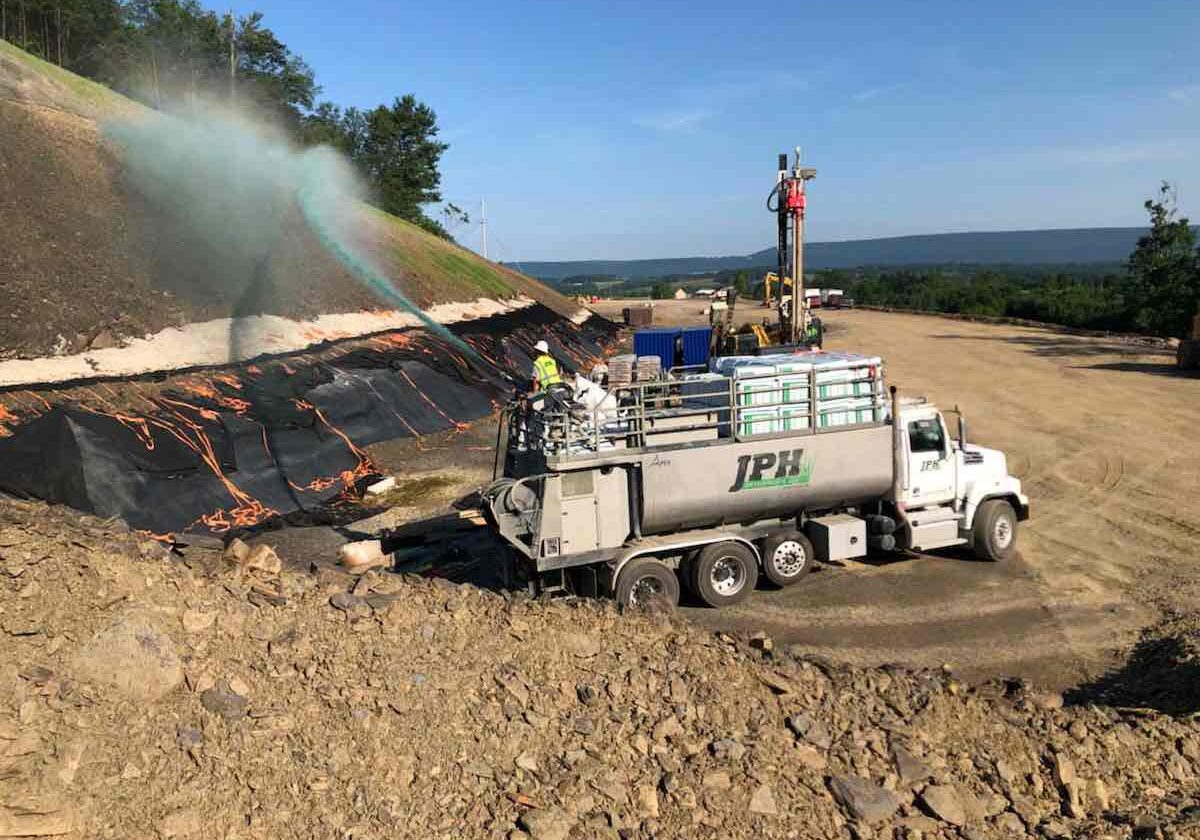Application Spotlight: Hydroseeding for Mine Reclamation

Share this article!
Mine reclamation is intended to mitigate any environmental damage from mine operations, such as habitat destruction, soil degradation, and water pollution. Reclamation is also used to support the native ecosystem’s regrowth and recovery for a more sustainable, healthy future for the impacted area.
The modern mining industry faces many evolving challenges such as the need to fulfill federal and local regulations regarding mining land reclamation, and how to address environmental issues like erosion and water pollution. Hydroseeding has emerged as an efficient tool in the mine reclamation process, helping accelerate mining site recovery and revegetation while also helping control and reduce air and water pollution.
What is Mine Reclamation?
Mine activities can significantly alter the landscapes where they are conducted, and can significantly degrade the ecosystem through forces like erosion and pollution. In an effort to reduce these effects on the land, mine reclamation works to restore and rehabilitate land impacted by mining. To accomplish this, mine reclamation uses a variety of techniques to restore balance and productivity to degraded sites including soil remediation, planting, erosion control, and water quality management.
The idea is to bring former mine sites back into harmony with the surrounding landscape and to ensure harmful chemicals or imbalances in the water, soil, or air are addressed, so the site can once again be safe, productive, and environmentally balanced for whatever purpose it may serve in its post-mining phase, whether that’s agriculture, recreation, or conservation.
Steps of Mine Reclamation
In the United States, any and all mine reclamation plans must be detailed ahead of time and approved by the US government. While these reclamation plans may vary site by site and according to the mine type (open pit, underground, eg.), plans must be completed and submitted before mining begins. These plans typically consist of the following steps:
- Land Contouring
- Mine operations often come with steep embankments or slopes, especially with open pit mines, which often means the area must be graded before any other restoration activities can be successful.
- Soil Restoration
- Most mine sites leave the surrounding soil degraded to a point that not much would be able to grow. Soil additives, fertilizers, and topsoil are generally introduced to balance the soil composition and support a healthier soil.
- Seeding and/or Planting
- Once the site is graded and the soil is healthy, vegetation is introduced to the landscape. Plants can include grasses and soil-stabilizing ground covers, as well as bushes, trees, or shrubs depending on the climate. Hydroseeding is especially well suited to mine reclamation seeding initiatives because it delivers seeds, water, fertilizers, and stabilizing materials simultaneously, helping mine reclamation operators cover several bases at once.
- Monitoring
- Because mining operations impact the land so severely, mine reclamation sites must be monitored for years after reclamation is complete to ensure remediation and reclamation efforts have been successful and that the area continues to support a healthy ecosystem.
Hydroseeding for Mining Sites
Hydroseeding in mining sites helps solve two of the biggest problems in mine reclamation: the steep terrain and sloping of the area, and the pervasive need to supplement the soil before any regrowth can occur.
Hydroseeding can be used in areas that many other seeding techniques can not, and is especially well suited to applying seed in steep, difficult-to-access terrain like open pit mines. The hydroseed spray can reach upwards of 360 feet, depending on the make and model of the hydroseeder, making just about every inch of a mine site coverable quickly and easily.
Additionally, the hydroseeding slurry can be used to supplement the soil based on the specific characteristics of the mined area. For example, if the soil is low in nitrogen, specific nitrogen-rich fertilizers can be added to the slurry to better balance the soil’s composition. Additional tackifiers and mulches can also be added to help the slurry stay in place while seeds establish.
Dust Control
The often exposed soil of mines and mine reclamation sites can easily become sources of airborne dust and pollutants which can adversely impact both the environment and public health. So whether it’s air quality or water pollution, the mine reclamation process needs to adhere to regulations regarding the site and its impact on the surrounding environment, and dust control is key to managing these impacts.
Effective dust control methods like hydroseeding grasses or ground covers and applying dust suppressants work to both mitigate environmental and health risks and improve the reclamation process itself by laying the foundation for a safer and more sustainable post-mine ecosystem.
Erosion Control
The steep nature of many mines makes erosion control crucial for reclamation. Disturbing the soil at steep grades accelerates natural erosive forces, often creating a perfect storm of erosion’s worst impacts on the environment.
As a result, hydroseeding for erosion control in mine reclamation is quickly becoming a reliable method to combat mine-related erosion. Hydroseeding slurry that combines seeds, mulch, fertilizer, and water, creates an ideal environment for seed germination and growth, helping desired plants establish and grow quickly — even with the challenging grades and soil conditions of mined areas. Plants that establish an extensive root base, like ground covers, can be chosen to create a natural erosion control mat under the ground, which both stabilizes the soil and reduces natural runoff from rain and wind.
Revegetation
Hydroseeding is especially effective at revegetating a mined area, not only because it can help control erosion, but also because it can be used to reintroduce native plant species.
Because seeding in this way facilitates the precise seeding of native plant species or erosion-controlling plants, it helps reestablish vegetation that meets federal and local ecological standards. This process also promotes biodiversity and helps restore the original habitat for other native plants and wildlife.
A process called hydrosprigging can also be used to supplement planting in a mined area. Hydrosprigging modifies the hydroseeding process to quickly plant the sprigs of shrubs, small trees, and bushes rather than seeds, adding versatility and efficiency to planting this type of vegetation.
Hydroseeding can help mining companies fulfill their reclamation duties
As the mining industry moves toward sustainability and increased environmental awareness, hydroseeding’s ability to expedite vegetation regrowth, mitigate erosion, control dust, and help restore the health of the greater ecosystem of a mined site supports both regulatory compliance and a more positive image of environmental responsibility within the industry. With help from hydroseeding, mining companies can more easily comply with federal and local reclamation regulations, while demonstrating what responsible natural resource use and land stewardship can look like. For additional resources on how hydroseeding can be used to solve a variety of regulatory and compliance issues across industries, reach out to our team.
